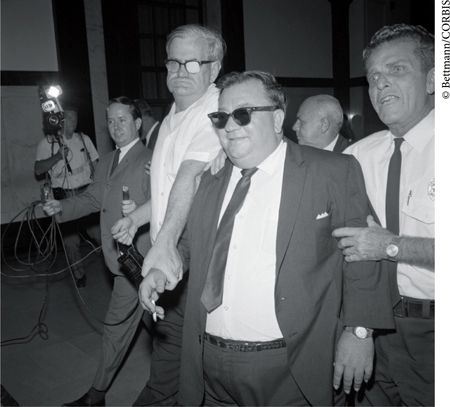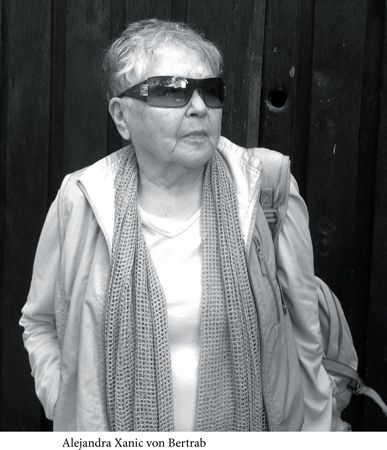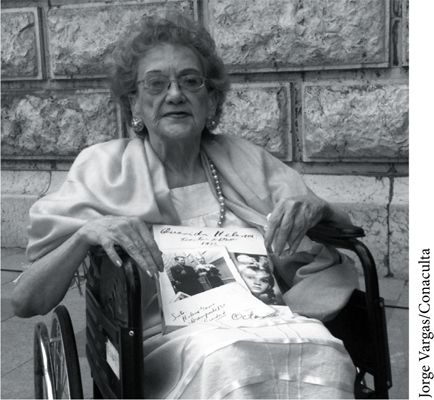A Cruel and Shocking Act: The Secret History of the Kennedy Assassination (111 page)
Read A Cruel and Shocking Act: The Secret History of the Kennedy Assassination Online
Authors: Philip Shenon

New Orleans District Attorney Jim Garrison claimed in 1967 that he had uncovered a conspiracy in the Kennedy assassination that the Warren Commission had failed to detect—or had covered up. He is shown with Mark Lane in New Orleans on March 28, 1967.

Garrison’s witnesses included colorful New Orleans lawyer Dean Andrews, who had earlier told the commission that he had been asked to go to Dallas to defend Oswald hours after the assassination. The request, he said, had been made by Oswald’s mysterious patron—“Clay Bertrand.” Andrews, shown being escorted by New Orleans sheriffs in August 1967, would later be convicted of perjury.

Silvia Duran, shown outside her home in 2013, still insists she never met with Oswald away from the Cuban consulate.

Helena Garro, daughter of Elena Garro, at a 2013 forum in Mexico City to honor her late mother; she says they saw Oswald at the Duran family party.

Duran’s claims are also rebutted by her former sister-in-law Lidia Duran Navarro, who recalls distinctly that Silvia talked of going on a date with Oswald.

Francisco Guerrero Garro, a prominent Mexican newspaperman, revealed in 2013 that he too had seen Oswald at the party.

In January 2013, Robert Kennedy Jr. revealed that his father had never accepted the Warren Commission’s findings. He is shown being interviewed in Dallas with his sister Rory and TV host Charlie Rose.
Acknowledgments
I began this project reluctantly. The Kennedy assassination is the most written about—and without doubt, most misunderstood—event in modern history, and I now know that many of the mysteries that surround November 22, 1963, will likely never be solved. As I explain elsewhere in these pages, I was led to this project because my first book was a history of the 9/11 Commission. It seemed logical to consider doing my next book on the Warren Commission, the other landmark federal investigation of a national tragedy in my lifetime. Still, I worried: Was I going to fall down the rabbit hole, pursuing the ultimate unknowable story? As a reporter, I usually begin an investigation with confidence that I will end up with the answers to most of my questions. I had no such confidence here, although five years later, I am convinced that
A Cruel and Shocking Act
does reveal startling new evidence about the assassination.
As I set to work on the research for this book, I was hit almost immediately by the realization that, by comparison, the terrible story of the 9/11 attacks was downright straightforward. The debate about the Kennedy assassination is an absolute morass, in part because of the failings of the Warren Commission, which clearly rushed its investigation and left so many questions unanswered despite the eagerness of its young staff investigators to get to the truth. (I am struck by the fact that the 9/11 Commission had twenty months to complete its work and did not begin investigating until after Congress had completed its own exhaustive inquiry. The Warren Commission was “finished” in half that time; it was established just seven days after the shots rang out in Dealey Plaza.) Some of the conspiracy theories about the Kennedy assassination are not so far-fetched, especially given the legal definition of conspiracy, which requires only that two people plot wrongdoing. If only one other person aided Oswald in a plot to kill Kennedy, there was by definition a conspiracy.
So I begin these acknowledgments by thanking a handful of writers, researchers, and historians whose books and other work gave me an all-important head start in trying to make sense of what is easily the most complicated story I have ever pursued. Since I am reaching for superlatives, I start by crediting the authors of what may be the single most intriguing government report I have ever seen—by Dan Hardway and Edwin Lopez-Soto, two then very young Cornell University law students who were recruited in the 1970s as staffers for the House Select Committee on Assassinations. Their report, entitled “Oswald, the CIA and Mexico City,” would not be declassified until the 1990s, and it gave me the essential road map that led me to the story of Charles Thomas, Elena Garro, and the “twist party” in Mexico City. Dan and Ed were generous with their time in interviews for this book.
Of the more than two thousand books published about the assassination, only a handful will still be read generations from now. And while I might fundamentally disagree with the conclusions of a few of these authors, I know that the essential library will always include Jefferson Morley’s remarkable
Our Man in Mexico
, which opened my eyes even wider to the unanswered questions about Oswald’s Mexico trip;
The Last Investigation
by Gaeton Fonzi;
Case Closed
by Gerald Posner;
Brothers in Arms
by Gus Russo and Stephen Molton;
Castro’s Secrets
by Brian Latell;
Conspiracy
by Anthony Summers;
Inquest
by Edward Jay Epstein;
Oswald and the CIA
by John Newman;
Brothers
by David Talbot; and Evan Thomas’s gracefully written and revealing
Robert Kennedy: His Life.
I deeply admire the work of the nation’s two great historians on the assassination—Max Holland, whose book
The Kennedy Assassination Tapes
is perhaps the best starting point for anyone who conducts research on this subject, and Vincent Bugliosi, whose 1,612-page masterwork,
Reclaiming History
, has sat on my desk for most of the last four years. I have read and reread Don DeLillo’s brilliant
Libra
and I marvel at how close I think his work of fiction might have come to the truth.
I’ve had a real partner in this undertaking: Kathy Robbins, who is my cherished friend and my literary agent, in that order. She is a born editor and has shaped this book in countless invaluable ways, all the while keeping my spirits up when the project threatened to overwhelm me. She is backed up at home and in life by another magnificent editor, her husband, Richard Cohen, whose suggestions have made this a much better, more readable book.
I am grateful to the legendary Stephen Rubin, president and publisher of Henry Holt and Company, for seeing the promise in this project, and for his patience. Steve is that rare thing: a true gentleman. There are many people at Holt or associated with Steve to thank, including Maggie Richards, Phyllis Grann, Pat Eisemann, Kenn Russell, Muriel Jorgensen, Emi Ikkanda, Meryl Levavi, and Michael Cantwell.
At the Robbins Office, I am thankful for the wise counsel of David Halpern, Louise Quayle, Katherine DiLeo, and their former colleagues Micah Hauser and Mike Gillespie. Thanks to photo researcher Laura Wyss and photo restorer Matthew Brazier for helping organize such a strong lineup of images. Laura and I are both grateful to Rex Bradford of the Mary Ferrell Foundation and Mark Davies of the Sixth Floor Museum in Dallas for all their assistance with the photos. JoAnne Hakala-Applebaugh was an intelligent, thoughtful research assistant and voice of good cheer.
My biggest stroke of luck was the discovery—through my friend and former
New York Times
colleague Ginger Thompson—of Alejandra Xanic Von Bertrab. Xanic, who often works for the
Times
out of Mexico City, is a phenomenal journalist and managed to track down many of the central characters in the tangled story of Oswald’s visit to Mexico; these are the people the FBI and the CIA ignored or missed fifty years ago. It was no surprise to me—but it was a delight—when Xanic won a Pulitzer Prize in 2013 for her part at the
Times
in exposing how Walmart used bribery to take control of much of Mexican retailing.
The talented Washington author Charles Robbins generously agreed to talk me through his understanding of some of the inner workings of the Warren Commission—knowledge he had gained as a former top aide to Senator Arlen Specter and as coauthor of the senator’s memoirs,
Passion for Truth
. Charles helped me arrange two of the last interviews that Specter, who died in 2012, would ever give to discuss his key role on the commission. Charles also graciously helped me track down some of the commission staff lawyers and others he had interviewed for the senator’s book.
